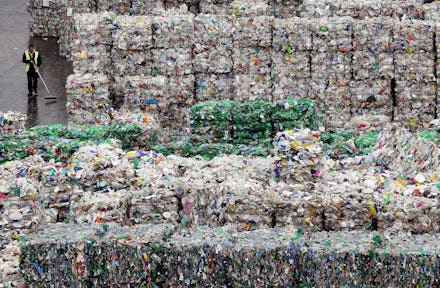Now that China won’t take Americans’ plastic waste, the U.S. is in the midst of a trash crisis

The problem of plastic waste in the United States is a troubling one. In 2014, fewer than 10% of U.S. plastic products were recycled; recent research says nearly 75% of all plastic ended up in landfills. Historically, the U.S. exported one-third of all its recyclables, curbing the problem of garbage piling up in our own backyards. China, the largest buyer of American recyclables, purchased scrap material from the U.S. estimated to be worth $5.6 billion in 2017 alone. But that all changed when China put a stop to its import of plastic waste in January. And we now have data that reveals how the plastic waste problem affects a number of nations and our own communities.
According to an analysis of data from the U.S. Trade Bureau conducted by Unearthed, Greenpeace’s investigative unit, U.S. plastic exports to a number of other countries are now on the rise. From January 2017 to June 2017, which was before China’s ban took effect, the U.S. exported just 4,000 metric tons of plastic to Thailand. During those same calendar months in 2018, the U.S. exported some 91,505 tons — an increase of 1,985%. Similarly, recyclable exports to Malaysia have risen 273% to 157,299 tons. The data revealed countries like Turkey and Canada are accepting more plastic garbage in greater amounts from the United States, too. Why is this a problem? Once countries decide to stop accepting our recyclables — which might be soon — the U.S. will have to find another home for them.
The sudden increase in recyclable materials poses a number of issues for nations absorbing America’s garbage problem. Since China’s ban, Malaysia has become a plastic dump site for a number of nations’ trash. Struggling to handle the influx of recyclables, in September the Malaysian government announced it would impose an import tax on scrap plastics and have tighter criteria on its acceptance of plastic.
Meanwhile, Thailand produces some 2 millions tons of plastic waste each year — already making the nation the sixth largest overall contributor of trash in the world’s oceans. In August, unable to handle the amount of imported trash, the Thai government announced that it would ban plastic imports over the next two years, which raises the question: Just where will the U.S. send its recycling to next?
Garbage troubles in the U.S.
The issue of piling plastic garbage can be felt in the U.S. According to WasteDive, an industry site that tracks how China’s ban on imported recycling affects each of the 50 states, many cities are adversely affected by rising distribution and processing costs and an overall loss in value for recyclable material. According to Graham Forbes, a global project leader at Greenpeace, the costs are the result of larger amounts of recycling to cope with, without readily available buyers like China, he said over the phone. A number of cities in California are struggling with increased costs associated with increasing contamination rates (when recyclables mix with nonrecyclables), and cities all over the country are forgoing recycling certain plastic products, or dropping plastic recycling programs altogether. (Before its ban, China would willingly purchase American recyclables with higher contamination rates, allowing the U.S. the luxury of lower quality control.)
Forbes said one of the largest contributors to the global plastic problem is single-use plastic, as in straws or six-pack rings. He added that large corporations play a significant role in its ongoing use. According to a 2018 report by Break Free From Plastic, Coca-Cola was the most prolific polluter during a recent clean-up effort: Its branded plastic was discovered in 40 out of 42 participating countries.
While a greater consumer awareness over recycling is necessary, it can’t solve the problem of plastic alone, Forbes said. “As an American consumer we have this belief that if we throw something [in the] recycling bin, it’s going to be processed in a responsible way and recycled back into something that’s usable,” he said. “What this is, is a wake-up call that this isn’t the case. ... The China ban underscores that the system is broken and that we need to re-envision our system. Twenty or 30 years ago, we were not reliant on [plastic] the way we are now — and it’s entirely possible for us to do things like that again.”